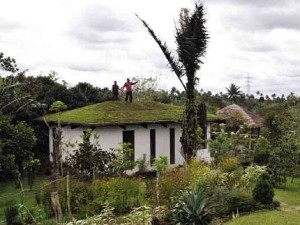
THE GARDEN roof of Filipina and German environmental advocate couple Agnes Calda and Christoph Ranzinger’s farm house in a town in Cavite, which was inspired by the public buildings in their home city in Munich where most government structures are made of green roof. Built from locally sourced materials in 2006, the Ranzingers’ house is surrounded by coconut trees, coffee plants, fruit trees and organic vegetables. They named their small farm Sintang Lupa, or Love of Earth, and turned their dream of building the first green roof in the Philippines into reality. Photo by ROMEO GACAD/AFP
The roof above our heads can do more than just shield our households from the scorching rays of the summer sun. In fact, architects stress that the roof’s heat-deflecting capabilities can be enhanced by these six easy-to-do steps:
1 Use a roof sprinkler. Install a simple sprinkler system on your roof using some of the used water stored in a tank or containers. Water is an effective way to cool down the roof, particularly during the hottest time of the day, and even at night. This sprinkler system can also primarily be set to water plants in the pots mounted in the roof.
2 Drying zone. Convert the roof area into a laundry drying zone. You can place clotheslines across the roof and hang your wet laundry there during the day—preferably late morning to late afternoon. Ideally, the wet laundry should be unwrung, so the water dripping from the laundry can also keep your roof wet (and cool).
3 Trellis power. Architect Boy Morcilla suggested to Inquirer Property that a decorative wooden or cement board trellis built over your roof could deflect sunlight, and at the same time allow air to flow freely on the roof. If you decide to do so, plan the orientation of the trellis members so that they can offer the maximum shade during the time they are most needed.
4 Nature on the roof. The trees and shrubs around your house add to that “green” factor, absorbing that heat-retaining greenhouse gas carbon dioxide, and giving off refreshing oxygen during the day. Yes, plants are cool, literally.
5 Proper materials for the roofing. If you’re one of the few who are about to buy a new home, how do you make sure that it is already naturally cool from the top? Make sure that the builder used the proper materials for the roofing. Galvanized aluminum is better than galvanized iron for deflecting heat. Gypsum boards can also do the trick.
6 A roof garden. Landscape architect Paulo Alcazaren can’t emphasize enough the importance of a roof garden. He shared a simple rule for greening a city congested with buildings: What you lose on the ground you replace with greenery on top.
Alcazaren explained that 1,000 square meters would be a fairly ideal area to maintain a roof garden. He added that a roof garden requires the proper selection of plants and maintenance of drainage and water supply.
He described most buildings’ roofs as predominantly empty spaces, with only the air-conditioning system, cooling towers of chillers, water tanks and remnants of unused construction materials occupying rooftops.
Putting together a green roof, however, is not just about dumping soil and sticking in plants left and right. A green roof must also achieve a balance of architecture, and at the same time strike a harmony with the greater surroundings. In this regard, the building owner would need a structural engineer and a professional landscape architect to design the whole space.
Once you plan to “green” your roof, do it correctly. Turning roofs into gardens has one immediate benefit: an estimated three- to five-degree reduction in temperature on the floors beneath.
A word of caution, though: As Philippine Association of Landscape Architects president Dickie Altavas revealed, a green roof executed incorrectly could be more of a problem than a solution.